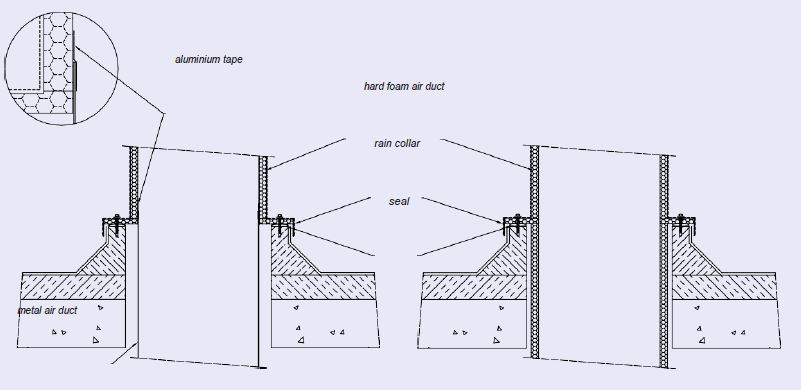2.6.2.1 Sheet quality
The hard foam ducts are manufactured from sheets with a minimum density of approximately 30 kg/m3. These sheets are faced on one or both sides with an aluminium foil with a minimum thickness of 60 microns.
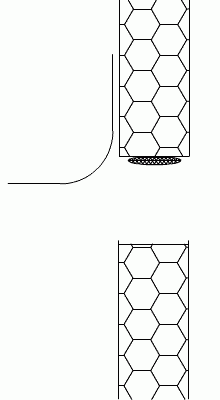
2.6.2.2 Sheet thickness
The hard foam air ducts are manufactured in the minimum panel thickness of 25 mm with a tolerance of +1.5 mm. With this thickness, the air ducts are manufactured in such a way that they are sufficiently rigid to withstand deformation.
2.6.2.3 Cross-connections
Cross-connections of hard foam air ducts are made in such a way that a sufficiently airtight connection is achieved. We make a distinction here between connections for air ducts in an indoor installation and air ducts in an outdoor installation.
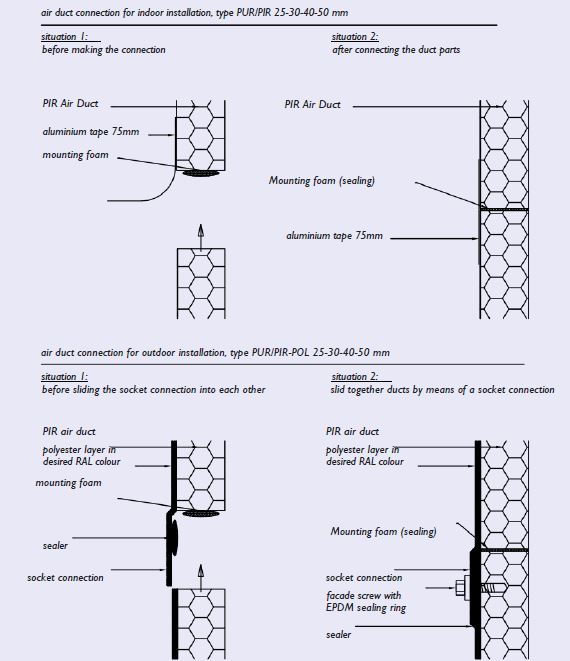
2.6.2.4 Longitudinal connections
The ducts are manufactured from a flat sheet, into which v-grooves are cut. These V-grooves are glued. The closing edges are cut at 45°, glued and finished with an aluminium tape with a minimum width of 75 mm and if necessary provided with e.g. connection clips. If the hard foam air ducts are provided with a polyester lining on the outside, an aluminium tape with a minimum width of 60 mm may be used.
2.6.2.5 Stiffening
Air ducts are designed to be sufficiently stiff so that no troublesome deformations occur. Assuming the application of the minimum sheet thickness in accordance with 2.6.1.2, duct surfaces are stiffened internally > 700 mm. Depending on the required specifications or application, the necessary plates and reinforcement pipes can be made of aluminium or galvanised steel.
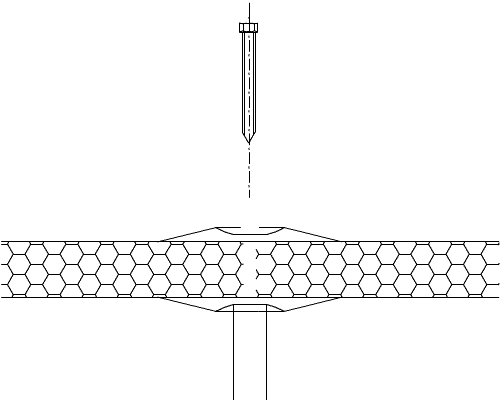
2.6.2.6 Execution possibilities
Some of the execution possibilities of hard foam air ducts are:
- PUR foam with a glass fibre reinforced polyester outer layer and analuminium casing inside, suitable for outdoor use;
- PIR foam with a glass fibre reinforced polyester outer layer and analuminium casing inside, suitable for outdoor use.
For the application of the polyester layer, assuming the application of the minimum sheet thickness according to 2.6.1.2, the following specifications apply:
- 450 gram/m² glass fibre for an internal duct size < 700 mm;
- 2x 450 gram/m² glass fibre for an internal duct size ≥ 700 mm.
2.6.2.7 Dimensions
The nominal sizes of the air ducts are given in mm and refer to the internal (net) dimensions with a tolerance of ±2 mm up to and including a side of 1200 mm; ±4 mm with a side larger than 1200 mm. The dimensions are standardised in accordance with the dimensions of rectangular metal ducts.
2.6.2.8 Visible work
If in an air technical installation a part of the air duct system has to be executed as 'visible work', this will be executed like the other duct work, unless it is mentioned otherwise in the specifications. Additional measures within the framework of visible work are normally not part of the standard execution.
2.6.2.9 Bends
Bends are manufactured as follows:
- Standard right angle bends are provided with blades or air turns;
- segment bends with an angle greater than 45° should be provided withblades.
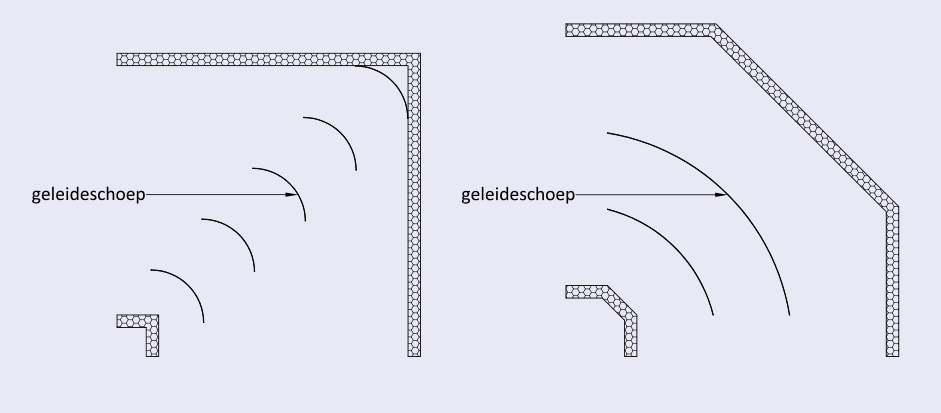
2.6.2.10 Adapters
Adapters are designed so that the top angle α is no more than 60°.
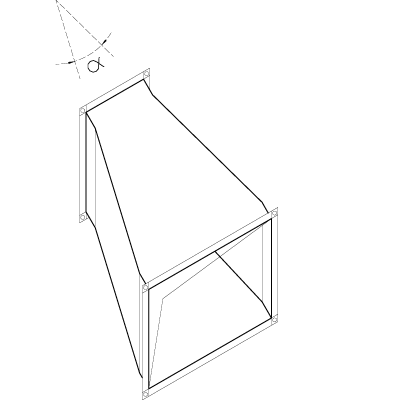
2.6.2.11 Branches
A branch (a split from a continuous main duct) can be realised by means of a straight or a flowing fitting and takes place at an angle of 90° maximum. Aerodynamic aspects also determine the type of execution.
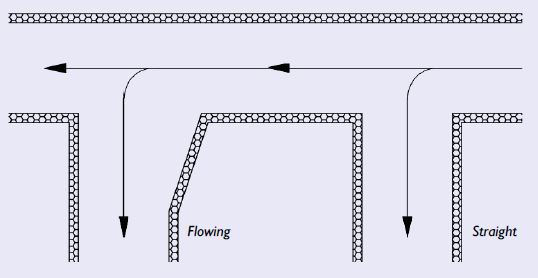
2.6.2.12 Adjustment valves
Adjustment valves are manually adjustable and serve to regulate an installation. They are provided with an appropriate locking device which also indicates the valve position. The damper blade, of the same material as the air duct, is executed in a single sheet with a thickness of at least 0.8 mm (executed according to the drawing below) up to a maximum blade width (B) of 300 mm and up to a maximum surface of 0.09 m². The edges of the damper blades are rounded and stiffened parallel to the axial direction.
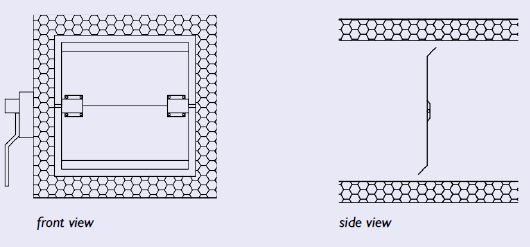
2.6.2.13 Erosion resistance
In order to guarantee erosion resistance, the ducts are internally finished with an aluminium coating. The air velocity in the duct system may not exceed 12 m/s at any point.
2.6.2.14 Permissible system pressure
The maximum permissible system pressure is 750 Pa. During a pressurisation test the air duct concerned is extruded once at a test pressure of 500 and once at a test pressure of 1000 Pascal.
2.6.2.15 Operating temperature
The maximum operating temperature for hard foam air ducts is 90°C.
2.6.2.16 Transition from plastic to metal
The transition from rectangular hard foam plastic ducts to metal air ducts can be achieved by following three principles.
Which principle is applied depends on the desired transition.
The choice of material for the transition depends on the steel air duct to be connected, for example galvanised steel, stainless steel or aluminium.
principle 1: the end side is finished with a metal U-profile;
principle 2: the end side is fitted with a metal air duct profile;
principle 3: a circular mouth is placed at the end or in the duct wall.

2.6.2.17 Connecting hard foam air ducts to roof transits
Plastic air ducts can be connected to roof transits by means of two principles. Which principle is applied depends on the desired situation.
Principle 1: The metal air duct extends approximately 50 mm through the roof curb. The transition from metal to plastic is made here. The roof transit is then weatherproofed.
Principle 2: The plastic air duct is installed under the roof structure. The plastic air duct is inserted through the roof curb. The roof transit is then weatherproofed. If required, the transition from plastic to metal can be made according to the principles described in chapter 2.6.1.16.
